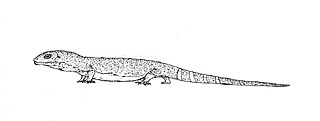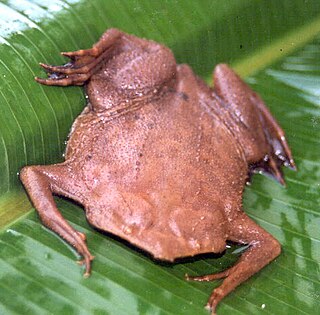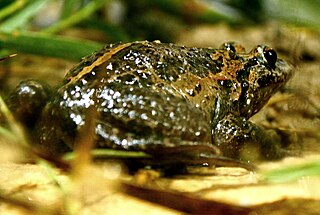
The European spadefoot toads are a family of frogs, the Pelobatidae, with only one extant genus Pelobates, containing six species. They are native to Europe, the Mediterranean, northwestern Africa, and western Asia.

Rana is a genus of frogs commonly known as the Holarctic true frogs, pond frogs or brown frogs. Members of this genus are found through much of Eurasia and western North America. Many other genera were formerly included here. These true frogs are usually largish species characterized by their slim waists and wrinkled skin; many have thin ridges running along their backs, but they generally lack "warts" as in typical toads. They are excellent jumpers due to their long, slender legs. The typical webbing found on their hind feet allows for easy movement through water. Coloration is mostly greens and browns above, with darker and yellowish spots.

The Chibanian, more widely known as the Middle Pleistocene, is an age in the international geologic timescale or a stage in chronostratigraphy, being a division of the Pleistocene Epoch within the ongoing Quaternary Period. The Chibanian name was officially ratified in January 2020. It is currently estimated to span the time between 0.7741 Ma and 0.129 Ma, also expressed as 774.1–129 ka. It includes the transition in palaeoanthropology from the Lower to the Middle Paleolithic over 300 ka.

Albanerpeton is an extinct genus of salamander-like albanerpetontid amphibian found in North America, Europe and Asia first appearing in Cretaceous-aged strata. There are eight described members of the genus, and one undiagnosed species from the Paskapoo Formation, making it by far the most speciose genus in the family. Members of the genus had a robust head and neck which likely allowed them to actively burrow, characteristic of fossorial species, and they lived in a wide range of environments. This genus of amphibian was the last of its order, surviving until into the Early Pleistocene (Gelasian) of northern Italy, and possibly northern Spain, until around 2 million years ago. It likely became extinct when the region developed its present Mediterranean-type climate, having preferred one that was cold and humid. The monophyly of Albanerpeton has recently been questioned, with some authors regarding the genus as paraphyletic.

Sinemys is an extinct genus of turtle from the Late Jurassic to Early Cretaceous of China. Three species have been named: S. lens, the type species, from the Kimmeridgian-Tithonian of Shandong; S. gamera, from the Valanginian-Albian of Nei Mongol, and S. brevispinus from Early Cretaceous of Nei Mongol. S. wuerhoensis, from the Aptian-Albian of Xinjiang, is not referrable to this genus. Specimen that may be belong to this genus were also known from Japan, although later abstract considered it as indeterminate sinemydid. The species S. gamera is noted for the presence of a pair of elongate spines projecting outwards and backwards from seventh costal of the carapace. These may have served a hydrodynamic function.

Diplocynodon is an extinct genus of alligatoroid crocodilian that lived during the Paleocene to Middle Miocene in Europe. Some species may have reached lengths of 3 metres (9.8 ft), while others probably did not exceed 1 metre (3.3 ft). They are almost exclusively found in freshwater environments. The various species are thought to have been opportunistic aquatic predators.

The Albanerpetontidae are an extinct family of small amphibians, native to the Northern Hemisphere during the Mesozoic and Cenozoic. The only members of the order Allocaudata, they are thought to be allied with living amphibians belonging to Lissamphibia. Despite a superficially salamander-like bodyform, their anatomy is strongly divergent from modern amphibians in numerous aspects. The fossil record of albanerpetontids spans over 160 million years from the Middle Jurassic to the beginning of the Pleistocene, about 2.13–2 million years ago.

Eopelobates is an extinct genus of frogs in the family Pelobatidae. Closely related to the living European spadefoot toad, it is known from the Eocene of western North America, and the Eocene–Pliocene of Europe. It is suggested that the distribution over both Europe and North America is due to dispersal during the Paleocene-Eocene Thermal Maximum.
Albionbatrachus is an extinct genus of prehistoric frogs from England and Romania, that spanned to the Eocene to Miocene. Two species are recognized:
Lithobatrachus is an extinct genus of prehistoric amphibian. It was described in 1929 by Hampton Wildman Parker based on a poorly preserved specimen that was first described as Hyla europaea by Gladwyn Kingsley Noble the year before. The two engaged in a debate whether the new genus was warranted. It might belong to the family Palaeobatrachidae, but this remains ambiguous.

Liaobatrachus is a genus of prehistoric frog, the first fossil specimen of which was recovered from the Yixian Formation of Liaoning Province, China. It was the first Mesozoic era frog ever found in China. The species Callobatrachus sanyanensis,Mesophryne beipiaoensis and Yizhoubatrachusmacilentus were classified as species of Liaobatrachus in one study, but this has been rejected by other authors. The genus has been considered a nomen dubium by some authors due to the poor preservation of the holotype specimen. Fossils were found in the Sihetun locality of the western part of Liaoning province, in the lower part of the Yixian Formation, and date to approximately 124.6 Ma. Another specimen was collected near Heitizigou, 25 kilometres (16 mi) south of Beipiao. The specimen has a snout–vent length of 69 millimetres (2.7 in). Liaobatrachus is considered to be the most basal member of Discoglossidae based on phylogenetic analysis.
Macropelobates is an extinct genus of prehistoric frogs. It was described by Gladwyn Kingsley Noble based on material from Oligocene of Mongolia.
Paralatonia is an extinct genus of prehistoric alytid frog from the late Cretaceous of Sânpetru and Densuş-Ciula Formation, Hațeg Island, in modern day Romania.
The White River Fauna are fossil animals found in the White River Group of South Dakota, North Dakota, Wyoming, Colorado and Nebraska in the United States. In southwest South Dakota and northwest Nebraska, these fossils are characteristic of the White River Badlands, though they can be found far beyond the limits of the White River watershed.

Pipoidea are a clade of frogs, that contains the most recent common ancestor of living Pipidae and Rhinophrynidae as well as all its descendants. It is broadly equivalent to Xenoanura.

Latonia is a genus of frogs in the family Alytidae. It contains only one extant species, the Hula painted frog which is endemic to Israel and was originally classified in the genus Discoglossus, though several fossil species are known from the Paleogene and Neogene periods spanning across Europe.

Palaeobatrachidae is an extinct family of frogs known from the Late Cretaceous to the Pleistocene primarily of Europe. They were highly adapted to aquatic life, like other members of the Pipimorpha. The oldest undoubted records of the family are from the lower Campanian of France. By far the most abundant genus is Palaeobatrachus, known from the Eocene to Pleistocene of Europe, with most other named genera in the family synonymised with it, the only exception being Albionbatrachus, which is distinguished from Palaeobatrachus by characters of its frontoparietals. The youngest fossils of Palaeobatrachus date to around 500,000 years ago, during the Middle Pleistocene after which they likely became extinct due to increasing aridity and freezing temperatures during the ice ages. Fossils of indeterminate palaeobatrachids are also known from the Pliocene and Early Pleistocene of Western Siberia.

Electrorana is an extinct genus of frog that lived in what is now Myanmar during the mid-Cretaceous, around 99 million years ago. The type and only species is E. limoae. The generic name is derived from the Latin electrum and rana, while the specific epithet is given in honour of Mrs. Mo Li, who purchased and provided the specimens for study.
This list of fossil amphibians described in 2018 is a list of new taxa of fossil amphibians that were described during the year 2018, as well as other significant discoveries and events related to amphibian paleontology that occurred in 2018.

Thaumastosaurus is an extinct genus of frogs in the family Pyxicephalidae. Five species are known, all from the Eocene of western Europe, including France, England, and Switzerland. Specimens of the species T. gezei from the Quercy Phosphorites of France are known for their exceptional preservation, providing three-dimensional images of the animal's life appearance.
















